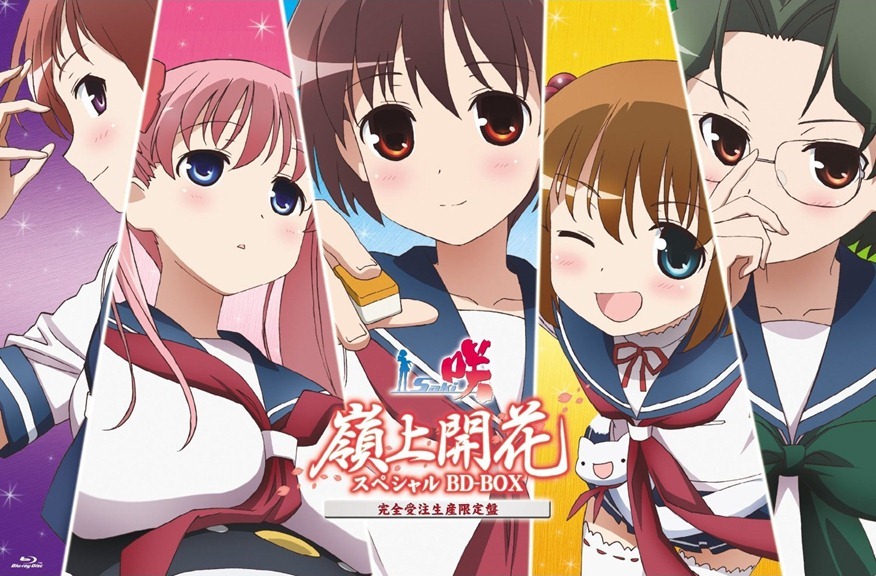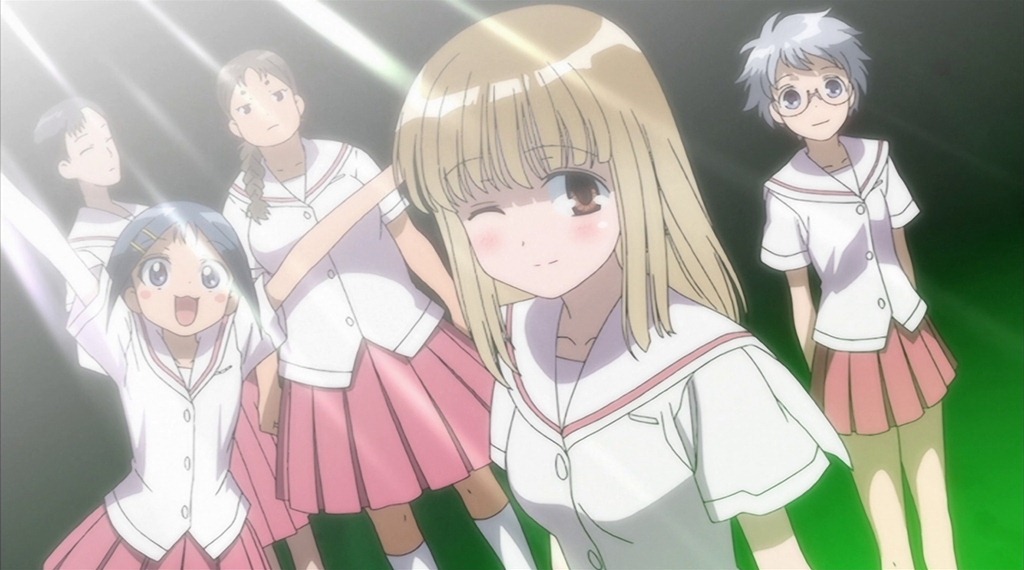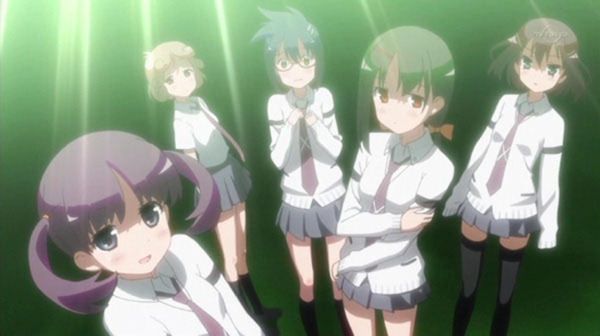
The Saki universe has two types of mahjong matches: individual and team matches. What we get to see in the anime is mostly the latter. But to be honest, most Saki teams are pretty crappy at doing this “team” thing. Shows like Chihayafuru make it clear that a team battle is something completely different from a set of individual battles, but the tag team matches in Saki often boil down to just that – a series of individual matches with a joint score. Which is not to say that the concept of a team is completely meaningless in the Saki universe. Let’s take a look at how major players in the series took advantage of team tactics (or failed to).
Kiyosumi
The good:
- placing Yuuki as vanguard and thus relieving her from the duty of thinking tactically about point differences (acknowledging and eliminating an individual’s weakness)
- Hisa concealing Nodoka and Saki’s ability level by having them go last in the team order, making it unnecessary for them to play seriously (or at all) before facing the strongest teams in the regionals
- Hisa helping develop the skills of all her other teammates
The bad:
- extreme differences in playing styles and approach to mahjong make it impossible for team members to give each other tactical advice, to the point that Nodoka outright refuses to listen to crucial bits of advice from her team captain

Kazekoshi:
The good:
- positioning matched to work against crucial opponents (vs Inoue Jun); learning from experience
- ace in the opening position lets the other team members play a calm, better game
- team captain offers tactical advice during match breaks
The bad:
- nobody but the captain ever does anything for the team – with around 80 members, there is nobody in the mahjong club to watch and analyze matches of rival teams in time for it to matter
- weaker members are completely unable to see the difference in ability between themselves and their opponents, failing to turn to a defensive style when necessary
Tsuruga:
The good:
- clear awareness of team members’ respective ability levels lets the first three players play a honest “survival-style” mahjong
- positioning may cause opponents to let their guards down, making them easy pickings for the best players waiting at the end
The bad:
- the fact that they have to give up three matches to begin with is pretty sad
Ryuumonbuchi:
The good:
- reliable ace in vanguard position sets the flow of the game in the team’s favor
- Koromo’s taishou position lets her play at night, at the peak of her ability
The bad:
- team members put personal issues over victory on a regular basis, Touka to show off, Koromo… for plenty of reasons
Achiga:
The good:
- Kuro in vanguard position acts like the usual ace against ordinary teams, and as damage control against monsters that outrank her (hands scored against her will be less expensive than average without dora)
- mentally tough taishou doesn’t let a chance for victory slip by for emotional reasons
- the coach is one of the most perceptive people in the Sakiverse, providing her team with crucial intel, as well as supporting them through training and other ways
The bad:
- damage control is all fine and dandy, but it is somewhat questionable if pitting Kuro against top tier opponents all the time is really the best use of her potential

Senriyama:
The good:
- as always, a vanguard ace is always a good idea, especially with Toki, who is the most powerful defensive player we have seen to date while being “only” very good on the offense, and therefore more suited to preventing the team form going into minus points rather than gaining back those points as a taishou
- team members actually adjust their playing style to the point totals in terms of offense/defense, playing cautiously when in the lead (why this is a rarity is beyond me)
- the team analyzes data of their opponents before a match (sorry Kazekoshi) and adjusts their tactics accordingly
The bad:
- the coach sets somewhat questionable goals before the team members, pressuring them into making risky decisions (insistence on first place)
Shiraitodai:
The good:
- reliable ace in vanguard position, backup ace in taishou position (perfect for any team which can afford it)
- willingness to study their opponents and pick the most “convenient” opponents to leave in-game, if possible
- team members show the initiative to study the team’s weaknesses and the playing styles of other teams in order to offer suggestions or countermeasures
The bad:
- the third and fourth player should just kill themselves… or practice playing mahjong without relying completely on their abilities

Considering the above points, the only team that acts like an actual team throughout the entire match is Senriyama. No wonder that they are ranked #2 in the country despite mostly lacking “supernatural firepower”.
But I did leave one team for last – Shindouji.
You see, a team like Senriyama has three ace-level players and their fourth can hold her own easy enough, so they can easily adjust their strategy by evenly shifting the pressure (the necessary points) between several players, not forcing anyone to bite more than they can chew. This also means that there is no need for complicated tactical decisions beforehand or precise role assignments.
Shindouji, on the other hand, only has two players who can comfortably take on monsters, so they are more like Kazekoshi in terms of combined ability level (okay, maybe slightly better). However, this is a team with an idea.
I mentioned above that putting your best players in vanguard and taishou positions is likely the best formation. That is exactly what most strong schools in Sakiverse do. The Shindouji team was made to destroy that formation.
Schools using that formation have weaker players in positions 2-3-4, and the last player (taishou) is their last resort in case something goes wrong. What happens when a school like that goes against Shindouji?
They get a fair share of points by throwing their ace at the sacrificial pawn Hanada. That said, we are talking about somebody who stopped Miyanaga Teru twice, once without the help of supernatural powers (I cannot even imagine what happened in that match). Whatever they get, it won’t last for long. Yoshiko comes next, and her sense of when to go for high point hands and when to go flushing everything down with silent trash hands is great. It might seem like her achievements during the match presented in the anime are not that great, but this is an unprecedented 15.000+ victory of a normal mahjong player over an elite ability user like Sumire. Lieutenant Ezaki might pull through or not (everything depends on the politics), but either way, club president Mairu is hot on her heels. Now comes the scary part. Mairu preying on the weaker vice captains should at best be enough to repair the damage done to Hanada. But the power difference is superimposed doubled on the taishou (captain) match, through Mairu and Himeko’s promised victories (reservation –> key). This is where Shindouji completely breaks the balance where pouring more strength into one battle should result in worse results in another. The more uneven the Mairu matchup is, the easier the next round becomes for Himeko. The taishou match, supposed to be a battle of equals, may very well turn into a slaughter in Shindouji’s favor.
It is indeed beautiful how each member contributes to the team strategy, be it Subara’s sacrificial pawn resolution or Yoshiko’s playing style adjustments against Sumire. But who set all this up remains a mystery. Shindouji’s coach has yet to make a proper appearance, while individual members were not informed about the precise reasoning behind their positioning (Subara was supposed not to know about the reasons behind her selection, Ezaki did not realize why the club president goes fourth etc.) Will we learn more about this team at a later date, or will it remain a mystery forever? Only time will tell.
Read Full Post »




